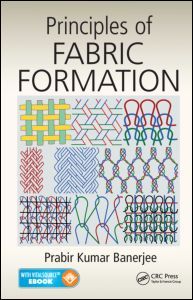Description
Principles of Fabric Formation
Author: Banerjee Prabir Kumar
Language: English
Subjects for Principles of Fabric Formation:
Keywords
Warp Sheet; Warp Yarns; 3-D Fabric-Formation System; Weft Yarns; Application of Composite Materials; Yarn Segment; Application of Electronics; Weft Tension; Basic Machine Elements; Weft Insertion; Basic Weaves; Warp Tension; Beating Up; Shed Line; Biaxial Weaving; Tuck Stitch; Braiding System; Reed Width; Creel; Weft Insertion Rate; Drafting and Lifting; Weaver’s Beam; Drive to Sley; Yarn Tension; Fabric Formation Systems; Horn Gears; Fabric Quality; Guide Bar; Fabric Selvedge; Yarn Sheet; Fabric Weave Design; Warp Shed; Fibers; Latch Needle; Functional Principles of Dobby; Warp Knitting Machines; Functional Principles of Jacquard; Lifting Plan; Geometry and Properties of a Loop; Braided Fabric; Geometry of Tubular Braids; Loom Shed; Knitting System; Needle Hook; Lacing Systems; Punching Density; Loop Formation; Shuttleless Looms; Machine Drive; Multiaxial 2-D and 3-D Fabrics; Multiphase Weaving; Narrow Fabric Weaving; Netting System; New Concepts of Jacquard Shedding; New Generation (Electronic) Jacquards; Next-Generation Shedding Systems; Nonconventional Weaving Systems; Nonwoven Fabrics; Nonwoven System; Package Build; Power Consumption; Precision Winding; Primary Motions; Principle of Shuttle Picking; Principles of Let Off; Principles of Shedding; Principles of Take Up; Process of Drawing In; QSC; Random Winding; Reinforcement of Web; Repeat and Shift; Secondary Motions; Shedding Motions; Shedding Tappet; Shogging Motion of Guide Bars; Shuttleless Weaving System; Shuttleless Weft Insertion System; Sizing Machine; Sizing Material; Sizing Systems; Surface-Driven Cone-Winding Machine; Techno-Economics; Textile Fabrics; Three-Dimensional Fabrics; Triaxial 2-D and 3-D Fabrics; Tubular Braiding Machine; Unwinding Behavior; Warp; Warp Knits; Warp-Knitted Fabrics; Warp-Knitting Machines; Warping; Warping System; Weaving Loom; Weaving System; Web Formation from Polymer Chips; Weft; Weft Insertion Systems; Weft Knits; Weft-Knitted Fabrics; Weft-Knitted Stitches; Weft-Knitting Machines; Yarn Sizing; Yarn Winding
Publication date: 12-2014
· 15.6x23.4 cm · Hardback
Publication date: 01-2018
· 15.6x23.4 cm · Paperback
Description
/li>Contents
/li>Biography
/li>
How Are Textile Fabrics Formed?
Principles of Fabric Formation is a treatise on the modern production systems of woven, knitted, braided, nonwoven, triaxial, multiaxial, and 3D fabrics. This book offers a basic understanding of the technicalities involved in the formation of different types of textile fabrics, and brings out the relative merits and limitations of each production process in one single volume.
Gain Insight into the World of Textile Fabrics
Providing readers with an appreciation of the technicalities involved in the formation of different types of textile fabrics, the author describes all major fabric formation methods, and explains each stage of formation in the text. He also addresses all major topics related to the formation of different classes of textile fabrics, including yarn winding, warping, yarn sizing, woven fabric construction, weaving, weft knitting, warp knitting, braiding, nonwovens, and triaxial, multiaxial and 3D fabrics.
Comprised of 16 chapters, this multifaceted work:
- Provides a technical description of fabric formation systems
- Focuses on the diverse technicalities involved in each and every stage of formation
- Contains a comprehensive compilation of the major principles involved
Principles of Fabric Formation
Textile Fabrics: An Overview. A Brief Outline of Various Fabric Formation Systems. Yarn Winding. Warping. Yarn Sizing. Basic Weaves and the Process of Drawing In. Primary and Secondary Motions of a Weaving Loom. Developments in Shedding Motions. Developments in Weft Insertion Systems. Features of Modern Shuttleless Weaving Systems. Nonconventional Weaving Systems. Formation of Weft-Knitted Fabrics. Formation of Warp-Knitted Fabrics. Formation of Braids. Formation of Nonwoven Fabrics. Formation of Triaxial and Multiaxial 2-D and 3-D Fabrics. Systems. References. Further Reading. Index.
Prabir Kumar Banerjee obtained his bachelor’s degree in textile technology from the College of Textile Technology, Serampore, West Bengal in 1966; master’s degree in textile engineering from IIT Delhi in 1973; and doctorate from the erstwhile TH, Karl-Marx-Stadt of GDR in 1979. He has guided nine PhD students, published 36 papers in refereed journals, developed eight new products and processes, and holds three patents. He is a recipient of the lifetime contribution award from the International Geosynthetics Society (Delhi Chapter) and the Central Board of Irrigation and Power of India for contribution to the growth of geosynthetics in India.




